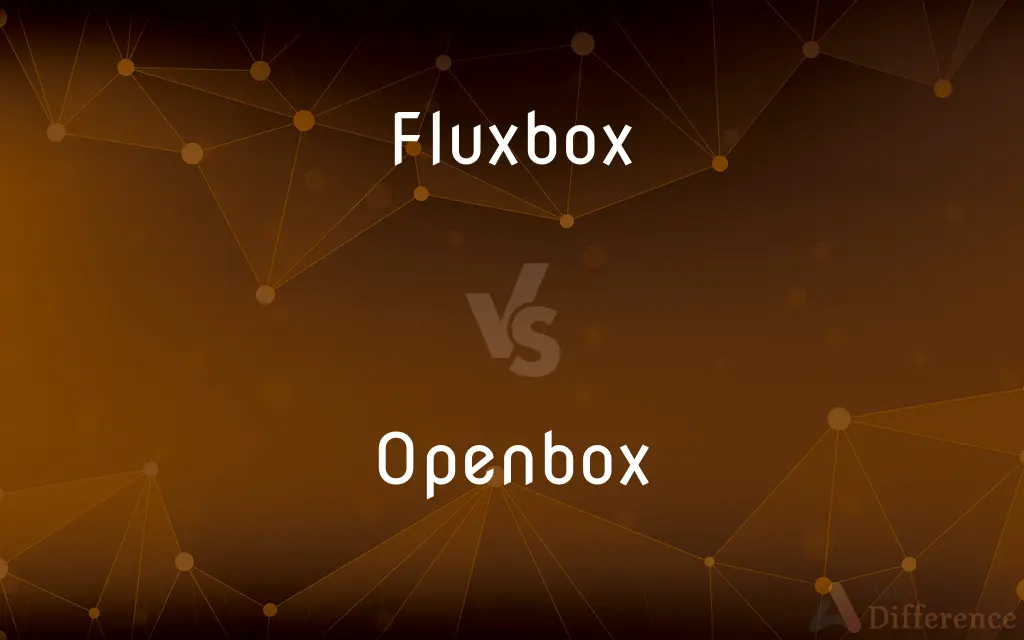Fluxbox vs. Openbox — What's the Difference?
By Tayyaba Rehman — Updated on September 20, 2023
Fluxbox is a window manager derived from Blackbox with added features, while Openbox is a standalone, highly configurable window manager. Both are used with Linux/Unix systems.

Difference Between Fluxbox and Openbox
Table of Contents
ADVERTISEMENT
Key Differences
Fluxbox originated as a fork of Blackbox, aiming to add more features and user-friendly tools. On the other hand, Openbox has a unique identity, though it was once based on Blackbox.
Fluxbox includes a built-in toolbar and slit (dock) for applications, which Openbox doesn't have by default.
Openbox stands out for its extensibility and highly configurable nature. While Fluxbox also offers customization, Openbox provides more flexibility in terms of theming and actions.
Fluxbox uses its own style files for themes, whereas Openbox employs XML-based theme files, making it more versatile in terms of design.
Openbox can be integrated with various desktop environments like LXDE. Fluxbox, though flexible, is generally used standalone.
ADVERTISEMENT
Comparison Chart
Origin
Forked from Blackbox with enhancements.
Initially based on Blackbox but evolved independently.
Features
Built-in toolbar and slit.
High extensibility and configurability.
Customization
Uses its own style files for themes.
Uses XML-based theme files.
Integration
Typically used standalone.
Can integrate with various desktop environments.
User-Friendliness
Contains some built-in tools for ease of use.
Requires user configuration but provides extensive flexibility.
Compare with Definitions
Fluxbox
Style Files for Themes: Utilizes its style files for customization.
I downloaded a new style file to change my Fluxbox theme.
Openbox
Integration Capabilities: Can be merged with other desktop environments.
I used Openbox with LXDE for a cohesive desktop experience.
Fluxbox
Derived from Blackbox: Originated as a Blackbox derivative.
Fluxbox retains some of Blackbox's core functionalities.
Openbox
XML-Based Themes: Employs XML for theming and configuration.
I edited the XML files to customize my Openbox appearance.
Fluxbox
Window Manager: A window manager for Linux/Unix systems.
I installed Fluxbox to have a lightweight desktop experience.
Openbox
Configurable Window Manager: A highly customizable window manager for Linux/Unix.
Openbox let me set up my desktop just the way I wanted.
Fluxbox
Standalone System: Typically used as an independent window manager.
On my old laptop, I used Fluxbox without any desktop environment.
Openbox
Independent Identity: Evolved from Blackbox but has its distinct features.
Though once based on Blackbox, Openbox stands on its own now.
Fluxbox
Built-in Toolbar: Comes with an inherent toolbar for user convenience.
Fluxbox's toolbar allowed easy access to my applications.
Openbox
User Configuration: Known for user-driven setups and customizations.
To optimize Openbox, I spent some time in user configuration.
Fluxbox
Fluxbox is a stacking window manager for the X Window System, which started as a fork of Blackbox 0.61.1 in 2001, with the same aim to be lightweight. Its user interface has only a taskbar, a pop-up menu accessible by right-clicking on the desktop, and minimal support for graphical icons.
Openbox
Openbox is a free, stacking window manager for the X Window System, licensed under the GNU General Public License. Originally derived from Blackbox 0.65.0 (a C++ project), Openbox has been completely re-written in the C programming language and since version 3.0 is no longer based upon any code from Blackbox.Openbox is designed to be small, fast, and fully compliant with the Inter-Client Communication Conventions Manual (ICCCM) and Extended Window Manager Hints (EWMH).
Common Curiosities
Can Openbox be integrated with desktop environments?
Yes, Openbox can be integrated with desktop environments like LXDE.
Which one originated from Blackbox, Fluxbox or Openbox?
Both have roots in Blackbox, but Fluxbox is a direct fork, while Openbox has significantly evolved since.
Does Fluxbox come with a built-in toolbar?
Yes, Fluxbox includes a built-in toolbar for user convenience.
Which is more user-friendly for beginners, Fluxbox or Openbox?
While both require some configuration, Fluxbox has some built-in tools that might be more user-friendly for beginners. However, Openbox provides extensive flexibility for those willing to delve into configuration.
Is Openbox more customizable than Fluxbox?
Both are customizable, but Openbox is known for its extensive configurability and flexibility.
What type of files does Openbox use for theming?
Openbox uses XML-based theme files.
How do I install themes in Openbox?
For Openbox, you can use XML-based theme files, which can be placed in the appropriate directory and then selected via the configuration tools.
Do both support keybindings?
Yes, both Fluxbox and Openbox support keybindings, allowing users to set shortcuts for various actions.
Is it possible to use Fluxbox and Openbox on older hardware?
Yes, both Fluxbox and Openbox are lightweight and can be used on older hardware for a faster desktop experience.
What's the main appeal of Fluxbox?
Fluxbox offers a lightweight desktop experience with some built-in features like a toolbar and slit.
Share Your Discovery

Previous Comparison
Excel vs. Tableau
Next Comparison
Peel vs. RindAuthor Spotlight
Written by
Tayyaba RehmanTayyaba Rehman is a distinguished writer, currently serving as a primary contributor to askdifference.com. As a researcher in semantics and etymology, Tayyaba's passion for the complexity of languages and their distinctions has found a perfect home on the platform. Tayyaba delves into the intricacies of language, distinguishing between commonly confused words and phrases, thereby providing clarity for readers worldwide.














































